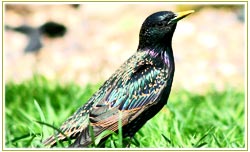About The European Starling
 The European Starling was introduced to North America in the early 1890’s when 100 species were released in New York City. Today, most European Starlings are found in the Midwest and Mid-Atlantic states and throughout Florida. The European Starling is a medium-sized, burly, black bird around 8.5 inches long with short tail and pointed wings. During summer, its feathers are black with purple or green sheen. Its bill is yellow and legs are reddish. During winter, its black feathers are speckled with white spots and its bill turns dark. Male and female Starlings look similar.
The European Starling was introduced to North America in the early 1890’s when 100 species were released in New York City. Today, most European Starlings are found in the Midwest and Mid-Atlantic states and throughout Florida. The European Starling is a medium-sized, burly, black bird around 8.5 inches long with short tail and pointed wings. During summer, its feathers are black with purple or green sheen. Its bill is yellow and legs are reddish. During winter, its black feathers are speckled with white spots and its bill turns dark. Male and female Starlings look similar.
The European Starling Nesting Preferences
European Starlings usually build their nests late in February and early March. They commonly nest in tree cavities, building edifices, between rafters in barns, open warehouses, fields and parks. These birds are very aggressive at claiming nest cavities, often times ejecting other birds like the Bluebirds and the Purple Martins from their nests. The male begins building a nest even before he has a mate but the majority of the nest is built by the female after she has found her mate. The nest is made from dried grasses, twigs, pine needles and lined with moss, feathers and fresh leaves. The female lays one egg per day. A normal clutch consists of 4 to 7 pale blue or green eggs. Incubation period is usually 11 to 15 days. During this period, both sexes incubate the eggs. The young leave the nest when they are 21 to 23 days old. Some pairs may return to nest in the same place around midsummer for a second brood.
Building a Birdhouse For The European Starling
 A preferred birdhouse for a European Starling has 6 x 6 inches floor and 16-24 inches inside ceiling. The diameter of the entrance hole is around 2 inches and the height of the center of the entry hole is 14-16 inches. Mount the birdhouse 10-25 feet above ground. European Starlings nest in areas ranging from rural and agricultural to urban areas but avoid wooded and mountainous regions.
A preferred birdhouse for a European Starling has 6 x 6 inches floor and 16-24 inches inside ceiling. The diameter of the entrance hole is around 2 inches and the height of the center of the entry hole is 14-16 inches. Mount the birdhouse 10-25 feet above ground. European Starlings nest in areas ranging from rural and agricultural to urban areas but avoid wooded and mountainous regions.
The European Starling Mating Habits
The male waves and half extends his wings and rotates while singing when a female flies close by. Soon after, the female selects her mate. European Starlings are basically monogamous although in some populations males may change mates between broods.
The European Starling Feeding Preferences
The European Starling is omnivorous. It eats a variety of invertebrates including snails, butterflies, grasshoppers, earthworms and spiders. It devours a wide range of seeds, grains and fruits both natural and planted. Its bill is well-adapted for digging into soil, poking holes in fruits, picking food from the ground or catching insects. It can open its bill while probing in the ground because of special strong muscles.
Interesting European Starling Facts
European Starlings were introduced in New York’s Central Park by Eugene Scheifflin who wanted to bring into the United States all birds mentioned in the works of William Shakespeare. They are exceptional mimics. They walk instead of hop like other birds do. They love to spread their wings akin to sun bathing.